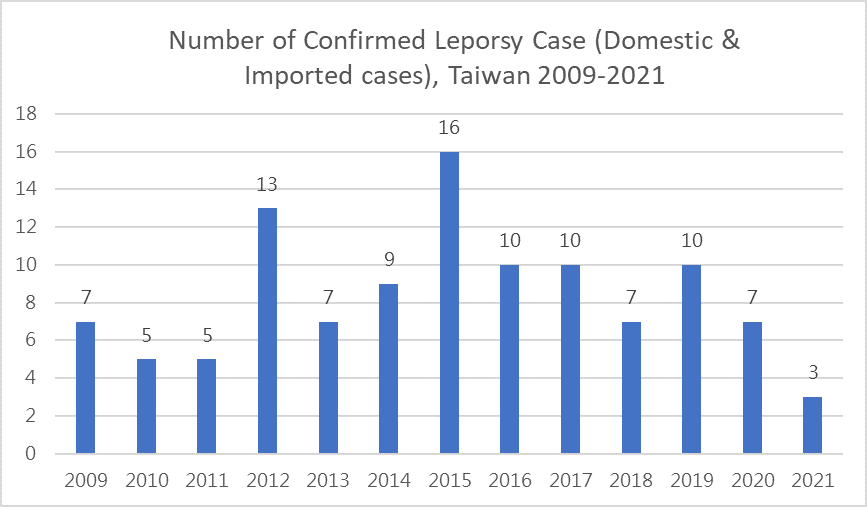Leprosy
Overview
Leprosy, also known as Hansen’s Disease, is a chronic infectious disease caused by Mycobacterium leprae (an acid-fast, rod-shaped bacillus). Leprosy can affect the nerves, skin, eyes, and lining of the nose (nasal mucosa). It is known to occur at all ages ranging from early infancy to very old age. Unfortunately, this disease is also associated with stigma, especially when deformities are present. With early diagnosis and treatment, the disease can be cured. People with Leprosy can continue to work and lead an active life during and after treatment.
Epidemiology
According to official reports, the global registered prevalence of leprosy at the end of 2020 stood at 129,192 cases (16.6 cases per 1,000,000 people), while the number of new cases detected during 2020 was 127,396 (16.4 new cases per 1,000,000 people). In Taiwan, every year, about 10 new cases were registered since 2009 to 2021. Most newly confirmed cases are imported cases or old-aged domestic population.

Sign & Symptoms
Up to 95% of patients exposed to M. leprae will not develop the disease, suggesting that host immunity plays an important role in disease progression and control. The incubation time is variable, ranging from 2 to 20 years, or longer.
Leprosy's clinical signs are easy to observe. Skin lesion has usually a different pigmentation than the surrounding normal skin (less pigmented, reddish or copper-colored) and may have various aspects (flat, raised or nodules, thick or stiff, dry skin). Skin lesion can be single or multiple and may show a loss of sensation in the skin (numbness, painless ulcers, painless swelling or lumps on the face or earlobes). Further, some symptoms are caused by damage to the nerves, such as, numbness of affected areas of the skin, muscle weakness or paralysis (especially in the hands and feet), enlarged nerves (especially those around the elbow and knee and in the sides of the neck) and eye problems that may lead to blindness (when facial nerves are affected).
Diagnosis & Treatment
According to World Health Organization (WHO) manual, Leprosy is diagnosed by finding at least one of the following cardinal signs:
- definite loss of sensation in a pale (hypopigmented) or reddish skin patch;
- thickened or enlarged peripheral nerve, with loss of sensation and/or weakness of the muscles supplied by that nerve;
- presence of acid-fast bacilli in a slit-skin smear.
Leprosy is a highly variable disease, affecting different people in different ways,according to their immune response. If leprosy case who with a high level of immunity, harbor a low number of bacilli and are referred to as patients with Paucibacillary (PB) leprosy. Those with many bacilli in the body are referred to as patients with Multibacillary (MB) leprosy. WHO revised the case definitions of PB and MB Leprosy as follow:
- Paucibacillary (PB) case: a case of leprosy with 1 to 5 skin lesions, without demonstrated presence of bacilli in a skin smear;
- Multibacillary (MB) case: a case of leprosy with more than five skin lesions; or with nerve involvement (pure neuritis, or any number of skin lesions and neuritis); or with the demonstrated presence of bacilli in a slit-skin smear, irrespective of the number of skin lesions.
Early diagnosis and complete treatment with multidrug therapy (MDT) remain the key strategies for reducing the disease burden of leprosy. In addition, BCG vaccine is an effective tool for prevention of leprosy. Standard MDT regimens for PB (two drugs) and MB (three drugs) leprosy were introduced in 1982. MDT is provided in blister packs, each containing 4 weeks’ treatment. Specific blister packs are available for MB and PB leprosy, with different doses for adults and children.
In Taiwan, people with Hansen’s disease would be treated at 5 designated hospitals run by the National Hansen’s Disease Program.
Prevention and Control
- Build effective epidemiological and post-treatment surveillance system and data management.
- Strategy in operation to build and sustain leprosy capacity among health care staffs.
- To raise the ability of contact tracing and integrated active case-finding in target populations for early diagnosis and prompt treatment with MDT.
- Well referral system, patient can access designated hospital easily and get adequate treatment and care.
- Combat stigma and ensure human rights are respected of leprosy patients.
FAQs
- What is Leprosy?
- Leprosy is a disease caused by a type of bacteria called Mycobacterium leprae. These bacteria attack nerves in the hands, feet and face, causing numbness and loss of sensation to those parts of the body. It can also affect the nose and the eyes.
- What are the signs and symptoms of Leprosy?
- Leprosy should be suspected if a person shows the following signs and symptoms: loss or decrease of sensation in the skin patch, numbness or tingling of the hand or feet, painful or tender nerves, swelling or lumps in the face or earlobes, and painless wounds or burns on the hands or feet.
- How does leprosy spread?
- Humans are the only significant reservoirs. The disease is believed to be spread through droplets from the nose or mouth of a patient to the skin and respiratory tract of another person. Transmission requires close and frequent prolonged contact with untreated, infected person. Indirect transmission is very unlikely. The bacteria multiply very slowly and therefore leprosy is not highly infectious. About 95% of people have natural immunity against leprosy.
- Is leprosy treatable?
- Yes, leprosy is treatable. It’s usually treated for at least 6 months for paucibacillary case, and at least 1 years for multibacillary case with a combination of antibiotics. MDT, a blister pack of combination of antibiotics, which is recommended by WHO.
- Where can leprosy cases receive treatment in Taiwan?
- Leprosy cases can go to 5 designated hospitals seek for treatment:
- Taiwan University Hospital, Taipei.
- MacKay Memorial Hospital, Taipei.
- Lo-Sheng Sanatorium and Hospital, MOHW, Taoyuan.
- Taichung Veterans General Hospital, Taichung.
- National Cheng Kung University Hospital, Tainan.
- Can migrant workers diagnosed with leprosy receive treatment in Taiwan?
- Migrant workers diagnosed with leprosy can receive treatment in Taiwan and retain right to work after complete the following process. Firstly, they need to sign the approval of “Directly Observed Treatment, Short Course (DOTS) Consent form for Foreign Employee”, and employers should submit the application documents to local health departments. Nevertheless, if migrant workers do not follow DOTS program more than 15 days, their health examination are regarded as failed, and their “Permit(s) to employ Foreign Worker” will be abolished and workers should be repatriated. Consequently, migrant workers are ill with leprosy should join DOTS and complete treatment, so as to protect their rights to health and work. For more details, please check Workforce Development Agency, Ministry of Labor (WDA) website.
- How can leprosy be prevented?
- BCG immunization.
- Early diagnosis & treatment of leprosy patients.
- Contacts tracing & be checked by a specialist of dermatology clinic when skin abnormalities occurred.
More Information
- WHO | Leprosy Today
- Hansen's Disease (Leprosy) | CDC
- United States National Hansen's Disease Program
Images


